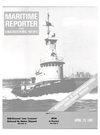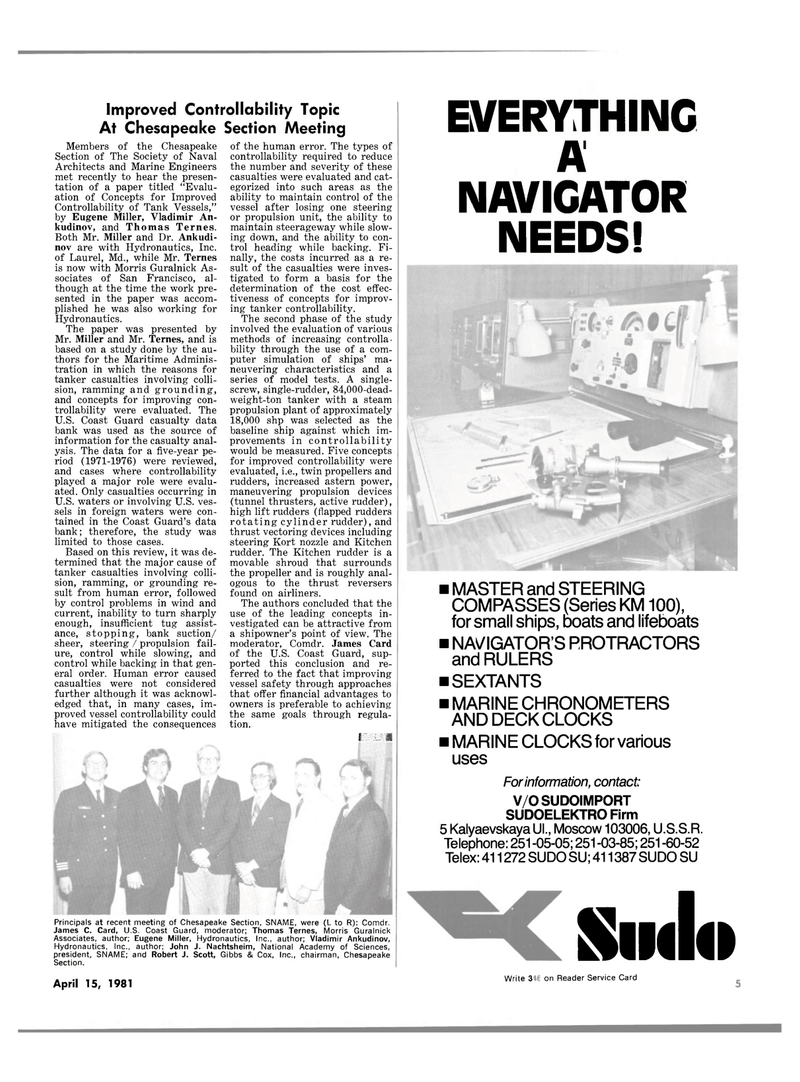
Page 3: of Maritime Reporter Magazine (April 15, 1981)
Read this page in Pdf, Flash or Html5 edition of April 15, 1981 Maritime Reporter Magazine
Improved Controllability Topic
At Chesapeake Section Meeting
Members of the Chesapeake
Section of The Society of Naval
Architects and Marine Engineers met recently to hear the presen- tation of a paper titled "Evalu- ation of Concepts for Improved
Controllability of Tank Vessels," by Eugene Miller, Vladimir An- kudinov, and Thomas Ternes.
Both Mr. Miller and Dr. Ankudi- nov are with Hydronautics, Inc. of Laurel, Md., while Mr. Ternes is now with Morris Guralnick As- sociates of San Francisco, al- though at the time the work pre- sented in the paper was accom- plished he was also working for
Hydronautics.
The paper was presented by
Mr. Miller and Mr. Ternes, and is based on a study done by the au- thors for the Maritime Adminis- tration in which the reasons for tanker casualties involving colli- sion, ramming and grounding, and concepts for improving con- trollability were evaluated. The
U.S. Coast Guard casualty data bank was used as the source of information for the casualty anal- ysis. The data for a five-year pe- riod (1971-1976) were reviewed, and cases where controllability played a major role were evalu- ated. Only casualties occurring in
U.S. waters or involving U.S. ves- sels in foreign waters were con- tained in the Coast Guard's data bank; therefore, the study was limited to those cases.
Based on this review, it was de- termined that the major cause of tanker casualties involving colli- sion, ramming, or grounding re- sult from human error, followed by control problems in wind and current, inability to turn sharply enough, insufficient tug assist- ance, stopping, bank suction/ sheer, steering / propulsion fail- ure, control while slowing, and control while backing in that gen- eral order. Human error caused casualties were not considered further although it was acknowl- edged that, in many cases, im- proved vessel controllability could have mitigated the consequences of the human error. The types of controllability required to reduce the number and severity of these casualties were evaluated and cat- egorized into such areas as the ability to maintain control of the vessel after losing one steering or propulsion unit, the ability to maintain steerageway while slow- ing down, and the ability to con- trol heading while backing. Fi- nally, the costs incurred as a re- sult of the casualties were inves- tigated to form a basis for the determination of the cost effec- tiveness of concepts for improv- ing tanker controllability.
The second phase of the study involved the evaluation of various methods of increasing controlla- bility through the use of a com- puter simulation of ships' ma- neuvering characteristics and a series of model tests. A single- screw, single-rudder, 84,000-dead- weight-ton tanker with a steam propulsion plant of approximately 18,000 shp was selected as the baseline ship against which im- provements in controllability would be measured. Five concepts for improved controllability were evaluated, i.e., twin propellers and rudders, increased astern power, maneuvering propulsion devices (tunnel thrusters, active rudder), high lift rudders (flapped rudders rotating cylinder rudder), and thrust vectoring devices including steering Kort nozzle and Kitchen rudder. The Kitchen rudder is a movable shroud that surrounds the propeller and is roughly anal- ogous to the thrust reversers found on airliners.
The authors concluded that the use of the leading concepts in- vestigated can be attractive from a shipowner's point of view. The moderator, Comdr. James Card of the U.S. Coast Guard, sup- ported this conclusion and re- ferred to the fact that improving vessel safety through approaches that offer financial advantages to owners is preferable to achieving the same goals through regula- tion. § a
Principals at recent meeting of Chesapeake Section, SNAME, were (L to R): Comdr.
James C. Card, U.S. Coast Guard, moderator; Thomas Ternes, Morris Guralnick
Associates, author; Eugene Miller, Hydronautics, Inc., author; Vladimir Ankudinov,
Hydronautics, Inc., author; John J. Nachtsheim, National Academy of Sciences, president, SNAME; and Robert J. Scott, Gibbs & Cox, Inc., chairman, Chesapeake
Section.
EVERYTHING A
NAVIGATOR NEEDS! • MASTER and STEERING
COMPASSES (Series KM 100), for small ships, boats and lifeboats • NAVIGATOR'S PROTRACTORS and RULERS • SEXTANTS • MARINE CHRONOMETERS
AND DECK CLOCKS • MARINE CLOCKS for various uses
For information, contact:
V/O SUDOIMPORT
SUDOELEKTRO Firm 5 Kalyaevskaya Ul., Moscow 103006, U.S.S.R.
Telephone: 251 -05-05; 251 -03-85; 251 -60-52
Telex: 411272 SUDO SU; 411387 SUDO SU
Smlo
April 15, 1981 5 Write 193 on Reader Service Card

 2
2

 4
4
